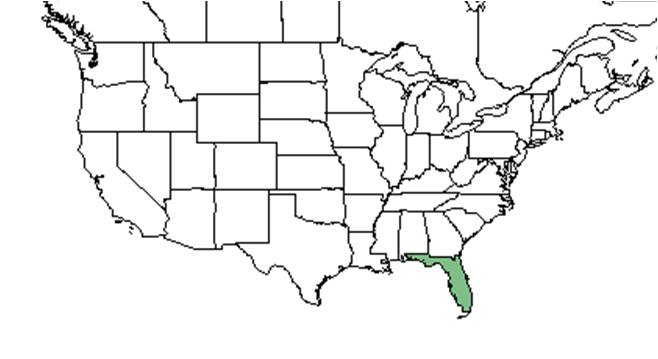Difference between revisions of "Chapmannia floridana"
KatieMccoy (talk | contribs) (→References and notes) |
KatieMccoy (talk | contribs) |
||
| Line 28: | Line 28: | ||
===Habitat=== <!--Natural communities, human disturbed habitats, topography, hydrology, soils, light, fire regime requirements for removal of competition, etc.--> | ===Habitat=== <!--Natural communities, human disturbed habitats, topography, hydrology, soils, light, fire regime requirements for removal of competition, etc.--> | ||
| − | In the Coastal Plain in Florida, ''C. floridana'' has been found in turkey oak/longleaf pine sand ridges; pine-palmettos | + | In the Coastal Plain in Florida, ''C. floridana'' has been found in turkey oak/longleaf pine sand ridges; pine-palmettos flatwoods; longleaf pine-wiregrass ridges; and scrub oak sand ridges. Human impacted areas include heavily cattle grazed longleaf pine-saw palmetto flatwoods (FSU Herbarium). |
===Phenology=== <!--Timing off flowering, fruiting, seed dispersal, and environmental triggers. Cite PanFlora website if appropriate: http://www.gilnelson.com/PanFlora/ --> | ===Phenology=== <!--Timing off flowering, fruiting, seed dispersal, and environmental triggers. Cite PanFlora website if appropriate: http://www.gilnelson.com/PanFlora/ --> | ||
Revision as of 15:26, 2 November 2015
| Chapmannia floridana | |
|---|---|

| |
| Scientific classification | |
| Kingdom: | Plantae |
| Division: | Magnoliophyta - Flowering plants |
| Class: | Magnoliopsida - Dicotyledons |
| Order: | Fabales |
| Family: | Fabaceae ⁄ Leguminosae |
| Genus: | Chapmannia |
| Species: | C. floridana |
| Binomial name | |
| Chapmannia floridana Torr. & A. Gray | |

| |
| Natural range of Chapmannia floridana from USDA NRCS Plants Database. | |
Common name: Florida alicia
Contents
[hide]Taxonomic notes
Description
Distribution
Ecology
Habitat
In the Coastal Plain in Florida, C. floridana has been found in turkey oak/longleaf pine sand ridges; pine-palmettos flatwoods; longleaf pine-wiregrass ridges; and scrub oak sand ridges. Human impacted areas include heavily cattle grazed longleaf pine-saw palmetto flatwoods (FSU Herbarium).
Phenology
Flowers appear May and June and fruits in May (FSU Herbarium).
Seed dispersal
Seed bank and germination
Fire ecology
Pollination
The following Hymenoptera families and species were observed visiting flowers of Chapmannia floridana at Archbold Biological Station (Deyrup 2015):
Apidae: Bombus impatiens
Halictidae: Augochlorella aurata, Augochloropsis metallica, Lasioglossum nymphalis, L. placidensis
Use by animals
Diseases and parasites
Conservation and Management
Cultivation and restoration
Photo Gallery
References and notes
Deyrup, M.A. and N.D. 2015. Database of observations of Hymenoptera visitations to flowers of plants on Archbold Biological Station, Florida, USA.
Florida State University Robert K. Godfrey Herbarium database. URL: http://herbarium.bio.fsu.edu. Last accessed: October 2015. Collectors: Loran C. Anderson, J. Beckner, D. Burch, J. Carmichael, A. Gholson Jr., R.K. Godfrey, Richard D. Houk, R. Kral, K.M. Meyer, Allen G. Shuey, A. Townesmith, D.B. Ward. States and Counties: Florida: Clay, DeSoto, Glades, Lake, Marion, Orange, Osceola, Polk, Seminole. Compiled by Tall Timbers Research Station and Land Conservancy.